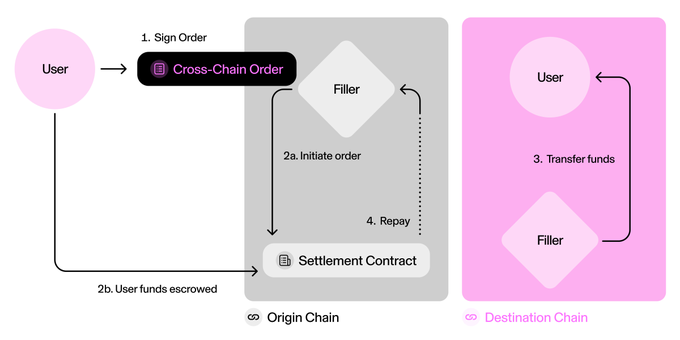How can "Unified" Ethereum be achieved? This article takes you further into the ERC-7683 standard.
Written by: Blurr
In the multi-chain landscape of the blockchain world, achieving safer and more convenient cross-chain interoperability has always been a challenging issue. As the demand for cross-chain transactions among blockchain users increases, the challenges faced in cross-chain interoperability become more pronounced. Common challenges include:
Security
Security is the most common challenge in cross-chain transactions, and cross-chain bridge protocols that can attract large-scale assets have become prime targets for hackers in recent years.
Blockchains rely on validators to verify and execute transactions, and cross-chain bridge protocols also need to depend on trusted third-party validators for verification and processing of cross-chain transactions. In this process, if the incentives for the cross-chain bridge are insufficient, the number of validators is low, or the trust model is overly centralized, hackers may attack the validators to compromise the cross-chain bridge and steal assets. Additionally, vulnerabilities in the cross-chain protocol's own contracts often serve as entry points for hackers to launch attacks.
On August 6, 2024, the Ronin Bridge reportedly suffered a hacker attack, resulting in the theft of approximately 4,000 ETH and 2 million USDC, with losses valued at around $12 million. In March 2022, the Ronin Bridge had already experienced a security incident referred to as the "largest loss in DeFi history," where hackers breached 5 out of 9 validators, stealing a total of 173,600 Ethereum and $25 million worth of USDC, with a total value exceeding $600 million.
High Gas Fees
Cross-chain transactions tend to incur higher Gas fees. Users need to calculate the actual transaction cost based on the Gas fees paid for operations on both chains before and after the cross-chain transaction.
Complexity
Each blockchain operates as an independent chain, with its own consensus mechanism and protocol. This fragmented and isolated state between chains leads to relatively complex and cumbersome operations for users when transferring assets and data across chains. Users with frequent transaction needs in cross-chain transactions are more likely to encounter asset price slippage, increasing the difficulty of transactions.
To address the above issues, Uniswap Labs and the interoperability protocol Across jointly proposed a new standard solution ERC-7683 on May 20, 2024, aimed at making cross-chain transactions simpler, faster, and safer through a shared execution network.
ERC-7683
The ERC-7683 standard is based on the CrossChainOrder structure and will provide an ISettlementContract smart contract interface, allowing for the implementation of standard APIs for cross-chain transaction execution systems.
The core technical proposal of the ERC-7683 standard is: all "cross-chain intents" follow the same order structure, which can greatly enhance the flexibility and user-friendliness of cross-chain operations.
As Uniswap Labs showcased on its social platform X, the goal is: The ERC-7683 standard provides a clear path for unified Ethereum.

△ Figure 1: Schematic diagram of cross-chain order structure under the ERC-7683 standard
Source: Uniswap Labs
Current Development Status
On August 21, 2024, the Layer 2 solution Optimism announced the adoption of the ERC-7683 cross-chain standard, aiming to achieve more efficient transfer operations for ETH and USDC on the Superchain and further promote application layer interoperability within the broader Ethereum ecosystem. Currently, Optimism has integrated the cross-chain solution from the interoperability protocol Across.
In May 2024, when releasing the ERC-7683 standard, Uniswap Labs stated that it would adopt this standard in its cross-chain collaboration with UniswapX.
It is worth noting that since the ERC-7683 standard only implements standard APIs for cross-chain transaction execution systems, which ensures consistency in user experience, even with the implementation of ERC-7683, it is still challenging to avoid a common issue in cross-chain transactions: Can sufficient cross-chain liquidity be obtained?
For the implementation of the ERC-7683 standard, if cross-chain liquidity is insufficient, it means that the standard will struggle to obtain enough active "Fillers" (refer to Figure 1) to support users' "cross-chain intents." If there are not enough "Fillers," users' "cross-chain intents" will not be able to achieve better costs or experiences through competitive mechanisms.
This means that the implementation of the ERC-7683 standard needs to create a wide-area effect—more use cases adopting the standard and more users utilizing the standard will lead to more Fillers, ultimately enhancing the overall efficiency of cross-chain transactions.
For more details on ERC-7683, please visit: https://www.erc7683.org
To view the Ethereum comment request jointly submitted by Uniswap Labs and Across to the Ethereum Magicians forum, please visit: https://ethereum-magicians.org/t/erc-7683-cross-chain-intents-standard/19619
Support from Ethereum Founders
Media reports indicate that Ethereum co-founder Vitalik Buterin has expressed special support for the development of the new cross-chain transaction standard ERC-7683 through social platforms, pointing out that operations based on the ERC-7683 standard can include batch processing transactions, Merkle proofs, and other on-chain activities. He illustrated how the ERC-7683 standard would function, stating:
"With the ERC-7683 standard, users can paste an ERC-7683 address into their wallet and then simply click once to easily transfer any asset on any chain to another account."
The multi-chain landscape is an inevitable development in the Web3 era, and for the next step in the development of the Web3 world, whether cross-chain transactions can be optimized, simplified, and further release liquidity will be a critical challenge. The ERC-7683 standard directly addresses the pain points of cross-chain transactions and can significantly enhance interoperability between blockchains. Its application will have a profound impact on the blockchain world. Currently, users can expect that the user experience improvements brought by the application of the ERC-7683 standard will provide direct benefits to more DeFi projects—injecting more liquidity support and accelerating development.
免责声明:本文章仅代表作者个人观点,不代表本平台的立场和观点。本文章仅供信息分享,不构成对任何人的任何投资建议。用户与作者之间的任何争议,与本平台无关。如网页中刊载的文章或图片涉及侵权,请提供相关的权利证明和身份证明发送邮件到support@aicoin.com,本平台相关工作人员将会进行核查。




